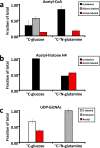Branched tricarboxylic acid metabolism in Plasmodium falciparum
- PMID: 20686576
- PMCID: PMC2917841
- DOI: 10.1038/nature09301
Branched tricarboxylic acid metabolism in Plasmodium falciparum
Erratum in
- Nature. 2011 Jan 20;469(7330):432
Retraction in
-
Retraction: Branched tricarboxylic acid metabolism in Plasmodium falciparum.Nature. 2013 May 30;497(7451):652. doi: 10.1038/nature12164. Epub 2013 Apr 24. Nature. 2013. PMID: 23615611 Free PMC article. No abstract available.
Abstract
A central hub of carbon metabolism is the tricarboxylic acid cycle, which serves to connect the processes of glycolysis, gluconeogenesis, respiration, amino acid synthesis and other biosynthetic pathways. The protozoan intracellular malaria parasites (Plasmodium spp.), however, have long been suspected of possessing a significantly streamlined carbon metabolic network in which tricarboxylic acid metabolism plays a minor role. Blood-stage Plasmodium parasites rely almost entirely on glucose fermentation for energy and consume minimal amounts of oxygen, yet the parasite genome encodes all of the enzymes necessary for a complete tricarboxylic acid cycle. Here, by tracing (13)C-labelled compounds using mass spectrometry we show that tricarboxylic acid metabolism in the human malaria parasite Plasmodium falciparum is largely disconnected from glycolysis and is organized along a fundamentally different architecture from the canonical textbook pathway. We find that this pathway is not cyclic, but rather is a branched structure in which the major carbon sources are the amino acids glutamate and glutamine. As a consequence of this branched architecture, several reactions must run in the reverse of the standard direction, thereby generating two-carbon units in the form of acetyl-coenzyme A. We further show that glutamine-derived acetyl-coenzyme A is used for histone acetylation, whereas glucose-derived acetyl-coenzyme A is used to acetylate amino sugars. Thus, the parasite has evolved two independent production mechanisms for acetyl-coenzyme A with different biological functions. These results significantly clarify our understanding of the Plasmodium metabolic network and highlight the ability of altered variants of central carbon metabolism to arise in response to unique environments.
Figures




Comment in
-
Metabolism: Malaria parasite stands out.Nature. 2010 Aug 5;466(7307):702-3. doi: 10.1038/466702a. Nature. 2010. PMID: 20686561 No abstract available.
Similar articles
-
Mitochondrial metabolism of sexual and asexual blood stages of the malaria parasite Plasmodium falciparum.BMC Biol. 2013 Jun 13;11:67. doi: 10.1186/1741-7007-11-67. BMC Biol. 2013. PMID: 23763941 Free PMC article.
-
Kinetic flux profiling elucidates two independent acetyl-CoA biosynthetic pathways in Plasmodium falciparum.J Biol Chem. 2013 Dec 20;288(51):36338-50. doi: 10.1074/jbc.M113.503557. Epub 2013 Oct 25. J Biol Chem. 2013. PMID: 24163372 Free PMC article.
-
Metabolism: Malaria parasite stands out.Nature. 2010 Aug 5;466(7307):702-3. doi: 10.1038/466702a. Nature. 2010. PMID: 20686561 No abstract available.
-
Glutamate synthesis has to be matched by its degradation - where do all the carbons go?J Neurochem. 2014 Nov;131(4):399-406. doi: 10.1111/jnc.12812. Epub 2014 Jul 23. J Neurochem. 2014. PMID: 24989463 Review.
-
Metabolic and mind shifts: from glucose to glutamine and acetate addictions in cancer.Curr Opin Clin Nutr Metab Care. 2015 Jul;18(4):346-53. doi: 10.1097/MCO.0000000000000178. Curr Opin Clin Nutr Metab Care. 2015. PMID: 26001655 Review.
Cited by
-
Recent advances in mapping environmental microbial metabolisms through 13C isotopic fingerprints.J R Soc Interface. 2012 Nov 7;9(76):2767-80. doi: 10.1098/rsif.2012.0396. Epub 2012 Aug 15. J R Soc Interface. 2012. PMID: 22896564 Free PMC article. Review.
-
Extraction and determination of flubendiamide insecticide in food samples: A review.Curr Res Food Sci. 2022 Feb 14;5:401-413. doi: 10.1016/j.crfs.2022.02.005. eCollection 2022. Curr Res Food Sci. 2022. PMID: 35243353 Free PMC article. Review.
-
Central carbon metabolism in Mycobacterium tuberculosis: an unexpected frontier.Trends Microbiol. 2011 Jul;19(7):307-14. doi: 10.1016/j.tim.2011.03.008. Epub 2011 May 10. Trends Microbiol. 2011. PMID: 21561773 Free PMC article.
-
Central carbon metabolism of Plasmodium parasites.Mol Biochem Parasitol. 2011 Feb;175(2):95-103. doi: 10.1016/j.molbiopara.2010.09.001. Epub 2010 Sep 16. Mol Biochem Parasitol. 2011. PMID: 20849882 Free PMC article. Review.
-
Mitochondrial metabolism of sexual and asexual blood stages of the malaria parasite Plasmodium falciparum.BMC Biol. 2013 Jun 13;11:67. doi: 10.1186/1741-7007-11-67. BMC Biol. 2013. PMID: 23763941 Free PMC article.
References
-
- Krebs HA, Johnson WA. The role of citric acid in intermediate metabolism in animal tissues. Enzymologia. 1937;4:148. - PubMed
-
- van Dooren GG, Stimmler LM, McFadden GI. Metabolic maps and functions of the Plasmodium mitochondrion. FEMS Microbiol Rev. 2006;30(4):596. - PubMed
-
- Sherman IW. In: Malaria, Parasite Biology, Pathogenesis and Protection. Sherman IW, editor. ASM Press; Washington, D.C.: 1998. p. 135.
Publication types
MeSH terms
Substances
Grants and funding
LinkOut - more resources
Full Text Sources
Other Literature Sources
Molecular Biology Databases
Research Materials
Miscellaneous

